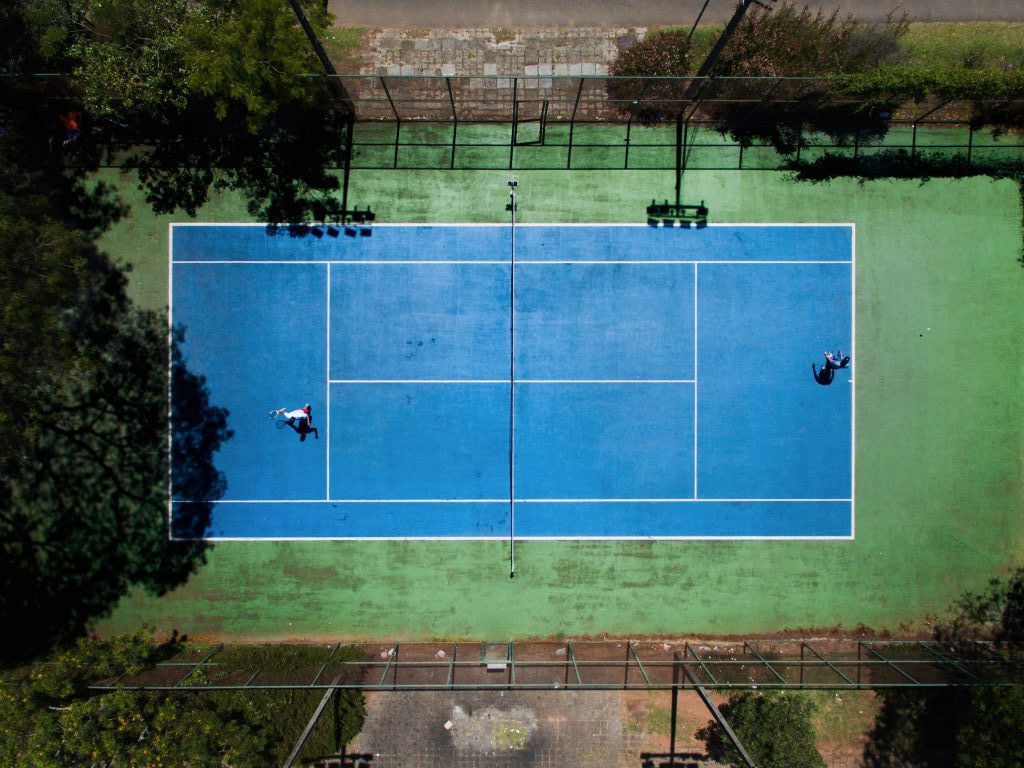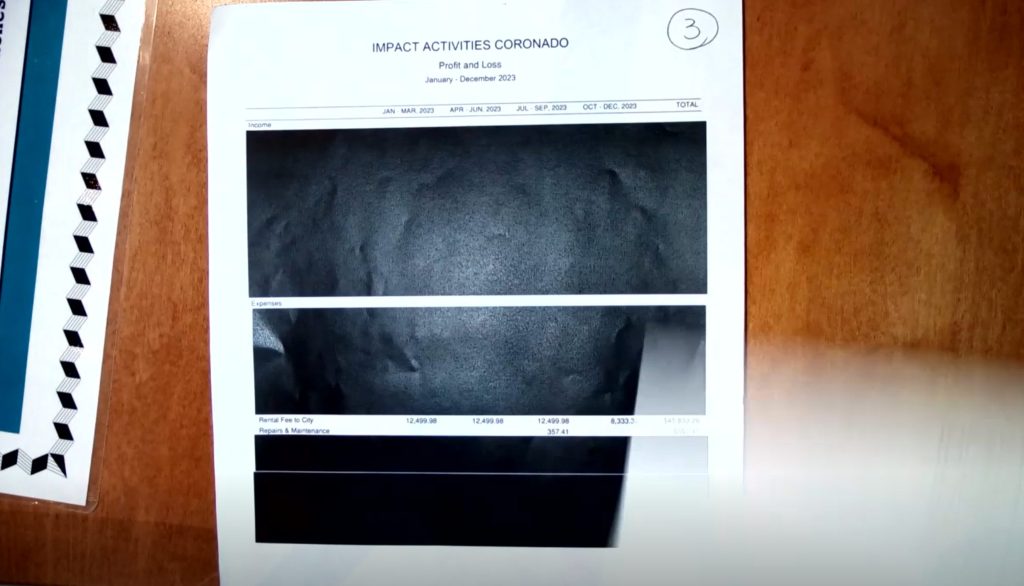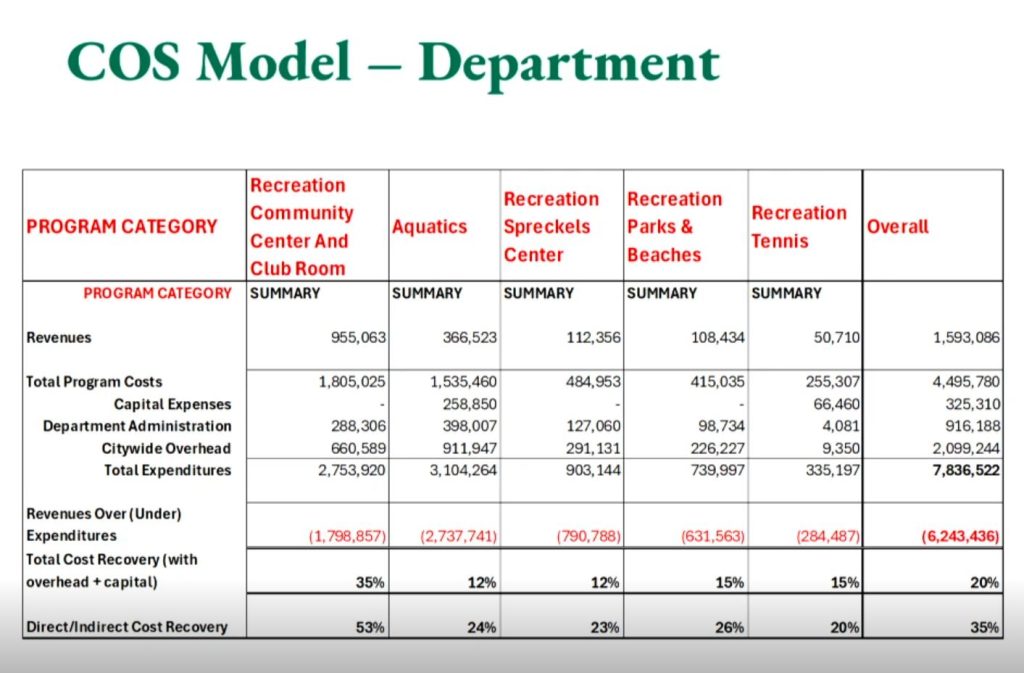
Editor’s note: This article was updated on Sept. 12 to include comment from Joel Myers, the city’s tennis director.
Carissa Hackworth has been playing tennis in Coronado for more than a decade – avidly.
“This is where my deepest friendships are, and were cultivated by playing tennis,” she said, her voice thick with emotion as she addressed the Coronado City Council.
Under the proposed rate increases for tennis court reservations in Coronado, Hackworth said, she will no longer be able to afford to play.
“This is what I do,” she said. “The main part of my week is being with these people, these friends, and being active. I fear I won’t be able to do it anymore.”
Coronado is updating its recreation fee schedule, which hasn’t been touched in decades. Members of the tennis community say the rate increase is unfairly steep. They came in droves to address the Coronado City Council as it heard a presentation on the proposed rate increases during its Sept. 3 meeting.
The council will make a decision on the matter during a public hearing at its Sept. 17 meeting. (Read more about the changes here.)
Critics of the proposal said it would levy a staggering increase on some tennis players, but supporters said the fees, which have not been increased in years, have been long in need of an increase.
Currently, courts in Coronado can only be rented in two-hour time slots. Just one person needs to book (and pay) for the court, which has space for up to four players.
The price varies based on court, but those at the Coronado Tennis Center are the most expensive. Currently, a two-hour slot costs $5 for a resident to rent ($15 for a nonresident).
Today, one resident would have to rent a court for $5 to play for two hours, with up to three other players. Under the proposed rate increase, each player would be charged, bringing the cost to $20 for a game between residents, a 300% increase.
Nonresidents face a steeper increase: If four nonresidents wanted to play in Coronado today, it would cost $15 total for two hours. Under the proposed increase, it would cost $20 per person.
Walk-on games are free.
And Hackworth, who lived in Coronado for years before moving to Imperial Beach, said she plays tennis here four to six times per week. She tearfully asked the council to reconsider the rate increase.
The rate increases, if approved as proposed, would be immediate for nonresidents, but staggered for Coronado residents.
At the tennis center, residents would be charged $1.50 per hour, per person, starting Jan. 1. In 2026, that rate would increase to $2 per hour, per person, and top off in 2027 at $2.50 per hour, per person. (However, the proposal also calls for the city to revisit its fees annually and tie increases to the Consumer Price Index.)
For nonresidents, if the proposal is approved, a court will cost $10 per hour, per person, starting on Jan. 1.
The city’s other courts will continue to be charged per court. Nonresidents would pay $10 per hour, per court starting Jan. 1. Residents would pay $3 per hour, per court in 2025. In 2026, the hourly rate would increase to $4, before it settles at $5 in 2027.
Many people, both residents and otherwise, supported Hackworth’s position during a two-hour presentation and discussion on the matter.
“Impact Acitivies is not charging for play, just for the privilege of private reservations,” said Joel Myers, the city’s tennis director, in emailed comments. “Fees have not been increased since around 2012, which is staggering. Comparisons of the surrounding San Diego facilities shows how far under market rate Coronado courts are for reservations. (They) will continue to stay below market rate, even at the peak of fees, three years from now.
“We support the three-year proposal,” Myers continued, “as it is both fair and essential for maintaining the highest level of service to the tennis and pickleball community.”
Tennis is the only of the city’s five parks and recreation categories that is privately managed. The other categories are parks and beaches, the John D. Spreckels Center, the Aquatics Center, and the Community Center and club rooms.
Coronado contracted Impact Activities to manage its tennis facilities in 2021, and its contract expires next year. Two members of the public spoke in favor of the increases, saying that Impact is doing a good job and has expenses of its own.
In fact, many people, even those opposed to the rate increase, agreed that Impact has done well in its role. Years ago, players who reserved courts would write their names on a chalkboard, only to return to find their names erased.
The criticism of Impact Activities instead fell to the lack of transparency that arises when a private company manages public facilities.
Coronado resident Rebecca King said she filed a public records request for the city’s costs of running its tennis center, brandishing a profit and loss report so heavily redacted, it was essentially a block of black.
In the middle of the page, were two small line items, showing the rental fee that Impact paid to the city (about $45,000) and a $357 repairs and maintenance entry.
She flipped to past years’ reports, which were also almost entirely redacted. No information about operating expenses, revenue, or profit was visible.
“You are asking them to conduct city business,” King said. “We’re entitled to know what they’re making, and we’re entitled to know where those fees are going.”

Indeed, city staff were unable to give specifics about Impact’s revenue. As a private company, it does not need to provide its financial records to the public. However, Tim Farmer, the city’s director of recreation and golf services, estimated that the fee change, once fully implemented, would generate about $190,000 in additional revenue for Impact, of which the city would be paid about $50,000 through a revenue sharing agreement.
That $50,000 would be on top of the rental fee that Coronado currently receives from Impact, meaning the city would be receiving about $100,000 annually for its tennis facilities, while Impact managed its operations.
Like the public, City Council members were also interested in learning more about the costs of contracting its tennis facilities management.
“Would it be more cost-effective to manage (the tennis program) in-house?” City Council Member John Duncan asked.
Farmer said he would attempt to run a cost analysis outlining as much ahead of the Sept. 17 meeting (during which the council will decide on the proposed fees), but said his estimation was that in-house operations would be more expensive than the current arrangements.
“We probably have the most skilled director to manage the courts,” Farmer said. “He just happens to contract through Impact Activities.”
City Council Member Carrie Downey backed this, pointing out that if the city hired even one person to act as tennis director, that person would need a salary and benefits, including a pension, in addition to all the other staff and operations costs involved with running the facilities.
The choice to contract Coronado’s tennis facilities, she said, was cost-driven.
“Several years ago,” Mayor Richard Bailey added, “we heard from members of the tennis community that they weren’t satisfied with the programming, that they weren’t satisfied with the operations as they currently were. So we, as a city council, were attempting to be responsive to the tennis community, which is why we went out to bid and ultimately picked Impact.”
Still, that choice led to a dearth of data about how tennis fees are utilized, a problem that does not exist with the other categories of the city’s parks and recreation department.
“When you raise fees in (the other categories),” City Council Member Casey Tanaka said, “you can kind of understand that all of that extra fee revenue goes to the city. My question about tennis is, it’s the only one on this list that has its own operator, and it’s hard for us to explain to the public why we’re raising the fees. … Is it fair? Is it exorbitant?”
However, he agreed that it was time for an increase.

City Council Member Mike Donovan echoed a suggestion that several people offered during public comment: That the city consider a membership model, in which players could pay an annual fee that affords them unlimited reservations. Other tennis clubs have similar programs.
But, Farmer said, Coronado has only 17 courts, fewer than most private clubs do. Based on data, the most popular time to play tennis is between 9 a.m. and 11 a.m., and opening up membership would likely cause an inventory issue that would leave would-be members dissatisfied.
Plus, Balboa Tennis Club, which has more than 1,400 members and 25 courts, has a waiting list to join. It is privately operated via special use permit from the city of San Diego and is not tax subsidized.
Duncan shared Farmer’s concern that membership might force more casual players off the courts to support the more serious players.
In 2016, Downey said, the council voted to increase tennis court reservation fees, but never did. Impact Activities entered its contract with the city expecting to charge more than they have been able to, she said. Impact is currently in negotiations with the city to renew its contract.
Ultimately, Downey said, they needed to decide how much of each recreational activity should be subsidized by the city and its taxpayers, who might not play tennis, or swim, or golf. Giving money to tennis would take away from something else, and the council needs to balance the needs of all its residents, she argued.
“Resources are finite, and we have a lot of projects coming up,” she said. “We don’t have unlimited funds, and there’s no other way to raise money (than charging fees).”




